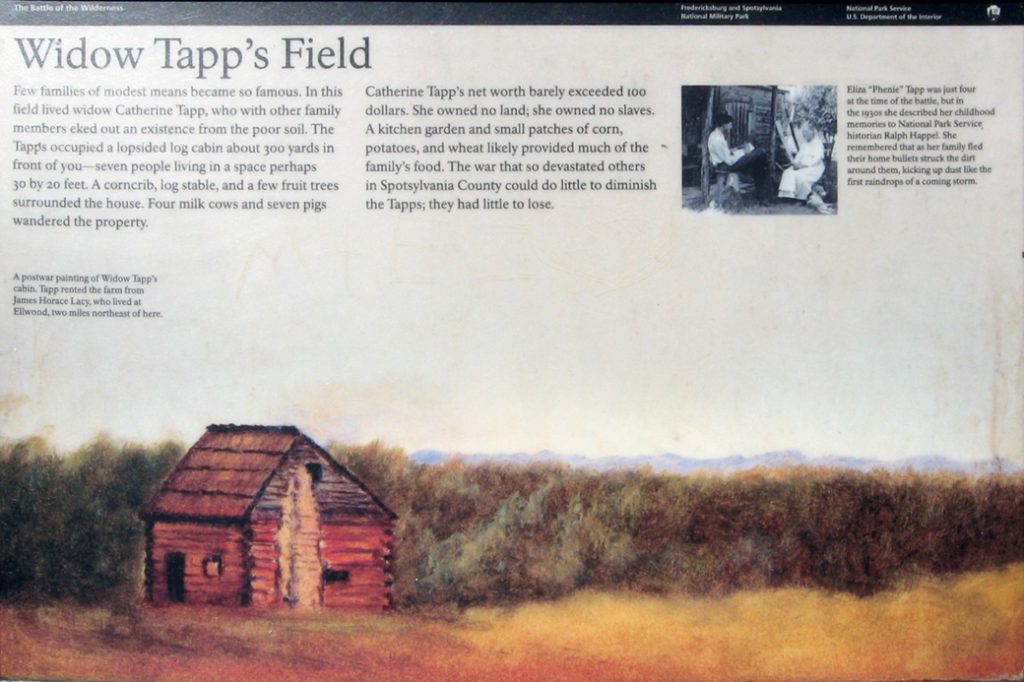Battle of the Wilderness • Tour the Battlefield • Monuments & Markers • The Armies
 The “Widow Tapp’s Field” and “Crisis in Tapp Field” wayside markers are a short distance from the pull-off at Tour Stop 6. A trail continues on across the field about half a mile to a pull-off along Orange Plank Road.
The “Widow Tapp’s Field” and “Crisis in Tapp Field” wayside markers are a short distance from the pull-off at Tour Stop 6. A trail continues on across the field about half a mile to a pull-off along Orange Plank Road.

The “Crisis in Tapp Field” (left) and “Widow Tapp’s Field” (right) wayside markers looking into Tapp’s Field.
Widow Tapp’s Field

Text from the marker:
Widow Tapp’s Field
Few families of modest means became so famous. In this field lived widow Catherine Tapp, who with other family members eked out an existence from the poor soil. The Tapps occupied a lopsided log cabin about 300 yards in front of you – seven people living in a space perhaps 30 by 20 feet. A corncrib, log stable, and a few fruit trees surrounded the house. Four milk cows and seven pigs wandered the property
Catherine Tapp’s net worth barely exceeded 100 dollars. She owned no land; she owned no slaves. A kitchen garden and small patch of corn, potatoes, and wheat likely provided much of the family’s food. The war that so devastated others in Spotsylvania County could do little to diminish the Tapps; they had little to lose.
Caption to the background painting:
A postwar painting of Widow Tapp’s cabin. Tapp rented the farm from James Horace Lacy, who lived at Ellwood, two miles northeast of here.
Caption to the photo at upper right:
Eliza “Phenie” Tapp was just four at the time of the battle, but in the 1930s she described her childhood memories to National Park Service historian Ralph Happel. She remembered that as her family fled their home bullets struck the dirt around them, kicking up dust like the first raindrops of a coming storm.
Crisis in Tapp Field wayside marker

Text from the marker:
Crisis in Tapp Field
Here on the morning of May 6, 1864, Confederate General Robert E. Lee and his army faced perhaps their greatest crisis. Soon after dawn, hundreds of disorganized Confederates tumbled from the woods to your left, driven by a powerful Union assault. As the Confederates swept past, only General Lee, his staff, and some 12 cannon stood between the Union army and Confederate disaster.
Southern reinforcements under Longstreet were on the way, but would they arrive in time to prevent Lee’s destruction? Lee fretted as he rarely had. The Confederate artillery fired furiously but only slowed the Federals. Then, as the Union troops advanced into this field, the Texas Brigade, the first of Longstreet’s corps, trotted eastward up the Plank Road.
Lee rode to the head of the column, intent on personally leading it into battle, but the Texans stopped him. “Lee to the rear!” they shouted refusing to move forward until the general retreated to safety. He did, and they moved forward – commencing a counterattack that would drive the Federals away.
Caption to the inset aerial photo:
The Tapp field today. A half-mile trail leads to key sites, including the site of Widow Tapp’s house, Confederate earthworks, and the Texas Brigade memorial.
Location of the markers
The “Widow Tapp’s Field” and “Crisis in Tapp Field” markers are about 50 feet south of Hill-Ewell Drive at the beggining of the trail into Tapp’s Field. (38°17’39.4″N 77°43’29.1″W)
